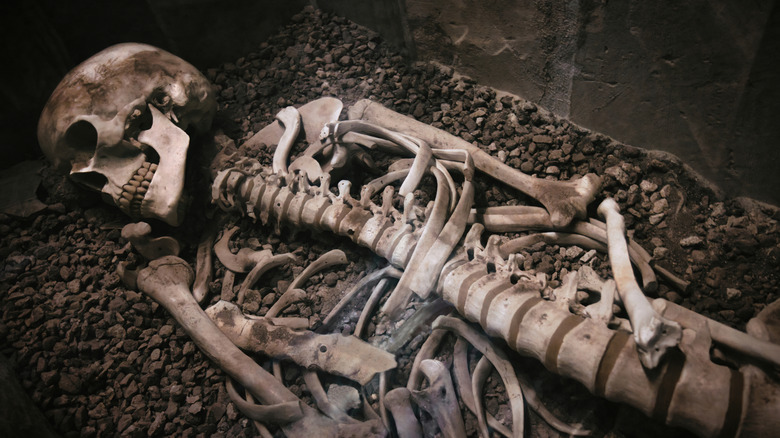Here's What Happens To Clothes On A Dead Person
Death is a delicate subject. Provoking fear, existential dread, and a vast array of unanswerable questions, it's usually one that people prefer not to think about at all. While it may be virtually impossible to know how and when we'll meet our end with complete certainty — and what comes afterward in a spiritual sense, if anything — what we do know is what happens to the human body after death. The decomposition process begins the moment a person expires, and unless the body is preserved or cremated, it steadily continues, taking around 10 years to skeletonize inside a coffin.
But have you ever wondered what happens to a dead person's clothes? After all, it's generally uncommon for people to be buried in the nude, and many religions have sacred traditions surrounding the attire a body is buried in. The simple answer is that a person's body isn't the only thing to decompose in a grave — their clothes do too.
In death, clothing decomposes with the corpse
Though you're not likely to find your old clothes rotting away in your closet (even if you haven't worn them in a decade), most clothing that sits in a landfill will eventually decompose. The rate of decomposition depends on whether the garment is spun from natural or synthetic materials. The Daily Sabah says that clothing made from 100% cotton (a natural material) takes between one week and five months to decay, while clothing made from polyester (a synthetic material) can last up to 200 years. So, what about clothing that's concealed inside a coffin on a decomposing body?
According to Business Insider, clothing made from natural materials like cotton is broken down by acidic fluids and toxins in the body and will fully decay in about a year. Meanwhile, nylon seams and waistbands remain intact because they are made of synthetic materials. When a body starts to decompose, however, the process takes between 10 and 15 years. This post-mortem process happens in four stages. The first is called autolysis, where the cells are destroyed by their own enzymes. It's what happens to your body when you've been dead for an hour. The next stage is bloating, in which foul-smelling gases emitted by bacteria cause the body to swell to up to twice its size. And finally, decay of body tissues and skeletonization complete the process. While clothing decomposition may not be as gruesome, it's significantly accelerated by that of the body's breakdown due to the release of bodily fluids that break down fabrics.
The clothing that the dead take to the grave
Unless they already had an outfit laid out for the occasion, when a person dies, their loved ones are often the ones who choose the burial clothes. Oftentimes, this involves dressing the deceased in a way that honors the way they dressed and expressed themselves in life. However, in some cultures and religions, tradition determines post-mortem wear. For instance, the Catholic faith dresses their dead in formal clothing, often with a crucifix or rosary in hand, and adorns bishops and priests in their traditional regalia that reflects their ranking in life. Meanwhile, in Jewish burial rituals, the body is wrapped in a plain white shroud called the tachrichim, signifying purity and equality under the eyes of God.
Similar shrouds are also used in Hindu, Muslim, and African cultures and are typically aligned with what is known as a green burial — meaning that the fabrics are ecologically friendly. Per Green Burial Council, "The shroud is as important as anything else we put in the grave, because the remains of decomposition are being considered in the overall ecology of the burial site." So, while clothing is destined to decay in the grave, by using natural fibers such as cotton, hemp, or wool, a green burial shroud honors the symbiotic relationship between human and earth, even in death.


